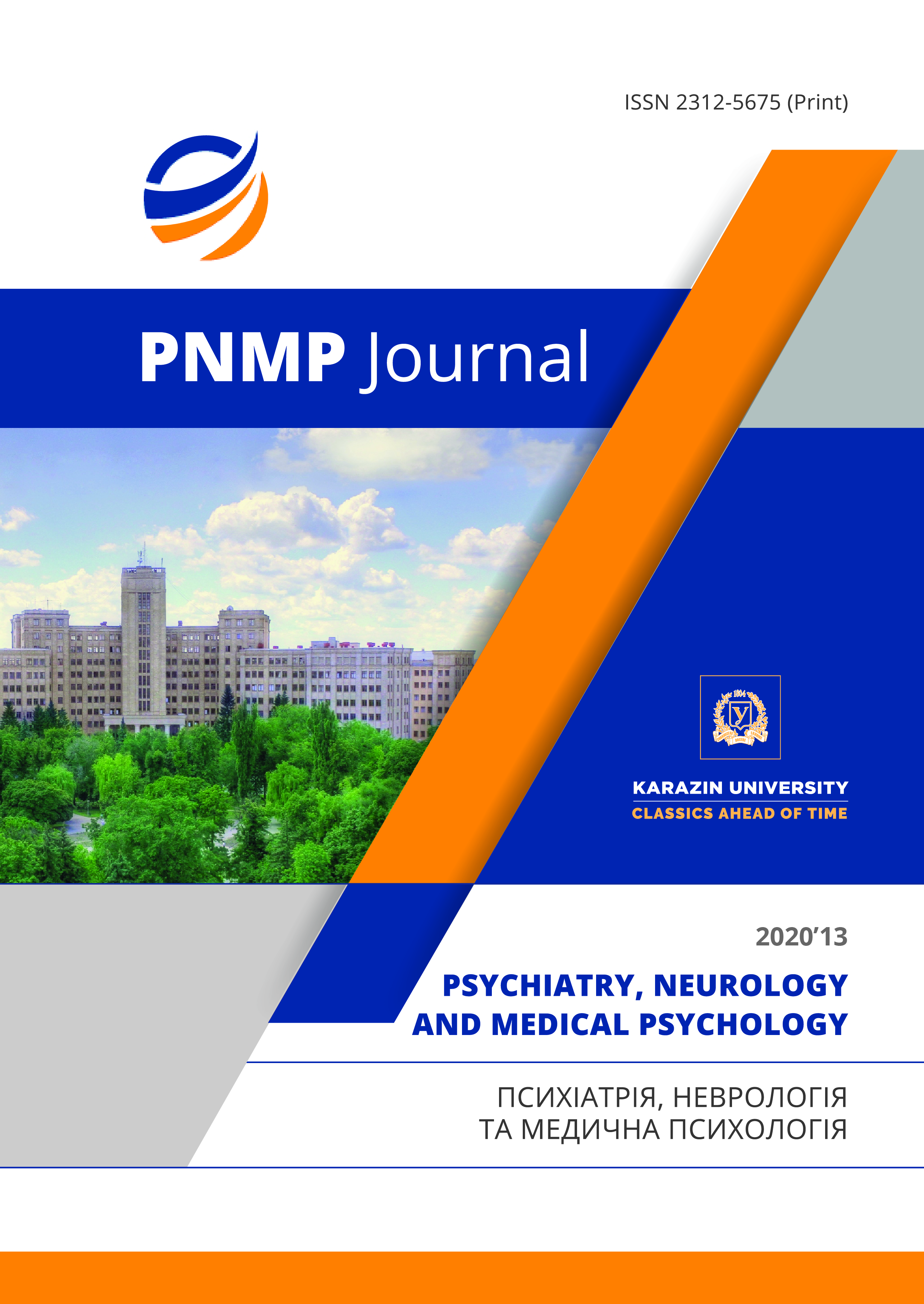The structure of cognitive and non-cognitive impairment in patients with hallucinatory-paranoid disorders in mixed dementia
Abstract
The aim of the study was to determine the specifics of cognitive impairment and clinic-psychopathological characteristics in patients with hallucinatory-paranoid disorders in mixed dementia.
In study involved 72 patients with hallucinatory-paranoid disorders in mixed dementia (main group) and 61 patients with mixed dementia without psychotic disorders (control group).
To achieve the goals and objectives of the study a comprehensive approach was used, which was implemented using the following research methods: the clinic-psychopathological method (a structured interview conducted as part of the clinical, phenomenological and psychopathological approaches in psychiatry), elementary neuropsychological studies of the main cognitive functions of patients (compilation of pictures, understanding of stories and plot pictures, establishing a sequence of events, classification, elimination of excess, highlight significant features, search for analogies, definition and comparison of concepts, formation of artificial concepts, selection antonyms words), held in a structured interview; Mini-Mental State Examination (MMSE) short mental state assessment scale; Montreal Cognitive Assessment Scale (MoCa); Behavioral Disorders Scale (BEHAVE-AD) and non-cognitive sections of the Alzheimer's Disease Rating Scale (ADAS-Non Cog). As a result of the study, features of cognitive impairment in mixed dementia with hallucinatory-paranoid disorders, which included: decreased concentration, impaired praxis, gnosis, delayed reproduction, counting skills, thinking (motivational, operational components of thinking and criticality) and orientation in one's own personality. The psychopathological features of hallucinatory-paranoid disorders in the structure of mixed dementia were determined, which included: delusions about dishonesty of others, hallucinations, disorders of the depressive spectrum, vagrancy, aimless activity (cognitive bulimia), inappropriate behavior, circadian rhythm disturbance, fear of being left alone.
The distinguished features must be taken into account in the process of diagnosis and treatment of patients with hallucinatory-paranoid disorders in mixed dementia.
Downloads
References
World Health Organization and Alzheimer’s Disease. International Dementia: a public health priority. 2012, p. 23. URL: http://www.who.int/mental_ health/publications/dementia_report_2012/en/.
Dementia. NICE CG42 (UK). National Institute for Health and Care Excellence. 2015, p. 58.
Geneva: World Health Organization. The epidemiology and impact of dementia: current state and future trends. 2015. URL: https://www.who.int/mental_health/neurology/dementia/dementia_thematicbrief_epidemiology.pdf
Maruta N.A. Early Dementia Intervention: Problems and Solutions. Ukrainian Medical Journal, 2019. URL: https://www.umj.com.ua/wp/wpcontent/uploads/2019/04/Cognit.pdf?upload [In Ukr.]
Slobodin T.N. Dementia of neurodegenerative origin (approaches to diagnosis and treatment). Ukraí̈nian Neurological Journal. 2012, no 3, pp. 9-19. [In Ukr.]
Wu Yu-Tzu, Fratiglioni L., Matthews F.E. et al. Dementia in western Europe: epidemiological evidence and implications for policy .The Lancet Neurology. 2016. Vol. 15 (1). pp. 116-124.
Maruta N.A., Potapov A.A., Mudrenko I.G., Sotnikov D.D. Clinical and psychopathological features of patients with suicidal behavior in a mixed form of dementia. Psychiatry, psychotherapy and clinical psychology. 2018. Vol. 8, no 1, pp. 46-59. [in Ukr.]
Alzheimer's International Organization and World Health Organization. Dementia: a public health priority. 2012. URL: https://apps.who.int/iris/bitstream/handle/10665/75263/%209789244564455_ru.pdf;jsessionid=FE8A6E82E30B21C278EDBD11597166F8?sequence=14
Pinchuk I.Ya., Chaykovsʹka V.V., Stadnyk L.A., Levada O.A., Pustovoyt M.M., Shyryayeva M.I. Actual nutrition of the Herontopsychological Institute: first-hand post. 2010. p. 431. [In Ukr.]
Chukhlovina M.L. Dementia: diagnosis and treatment. 2010. p. 266. [In Russ.]
D'Onofrio G., Sancarlo D., Panza F., Copetti M. et al. Neuropsychiatric symptoms and functional status in Alzheimer's disease and vascular dementia patients. Curr. Alzheimer Res. 2012. Vol. 9 (6). рр. 759-771.
Donovan N.J., Wadsworth L.P., Lorius N., Locascio J.J., Rentz D.M. Regional Cortical Thinning Predicts Worsening Apathy and Hallucinations Across the Alzheimer Disease Spectrum. Am. J Geriatr. Psychiatry. 2014. V. 22 (11). рр. 1168-1179.
Folstein M.F., Folstein S.E., McHugh P.R. “Mini-mental state”. A practical method for grading the cognitive state of patients for the clinician. J. Psychiatr. Res. 1975. Vol.12 (3). рр. 189-198.
Nasreddine Z.S., Phillips N.A., Bedirian V. et al. The Montreal Cognitive Assessment MoCA: a brief screening tool for mild cognitive impairment. J. Am. Geriatr. Soc. 2005. Vol. 53 (4). рр. 695-699.
Reisberg B., Auer S.R., Monteiro I.M. Behavioral pathology in Alzheimer’s disease (BEHAVE-AD) rating scale. Int. Psychogeriatr. 1996. Vol. 8 (3). pp. 301-308.
Jacqueline K. Kueper, Mark Speechley and Manuel Montero-Odasso. The Alzheimer’s Disease Assessment Scale–Cognitive Subscale (ADAS-Cog): Modifications and Responsiveness in Pre-Dementia Populationsюю A Narrative Review. J Alzheimers Dis. 2018. Vol. 63 (2), рр. 423-444.
Mendelevich Ye.G. Cognitive and non-cognitive neuropsychiatric disorders in dementia and methods for their correction. Nevrologiya, neyropsikhiatriya, psikhosomatika. 2017. Vol. 9, no. 2, рр. 65-70. [In Russ.]
Kolykhalov I.V. Non-cognitive mental disorders in Alzheimer's disease: epidemiological, clinical, psychopathological, prognostic and therapeutic aspects. 2017. 48 p. [In Russ.]
Damulin I.B. Cognitive disorders in cerebrovascular pathology. Medicine and pharmacy news. 2011, no 5, p. 356. URL: http://www.mif-ua.com/archive/article/16362 [In Ukr.]
Gorelick P.B., Scuteri A., Black S.E., Decarli C., Greenberg S.M., Iadecola C., et. al. Vascular contributions to cognitive impairment and dementia: A statement for healthcare professionals from the American Heart Association/American Stroke Association. Stroke. 2011. Vol. 42, рр. 2672–2713. DOI: 10.1161/strokeaha.111.634279

